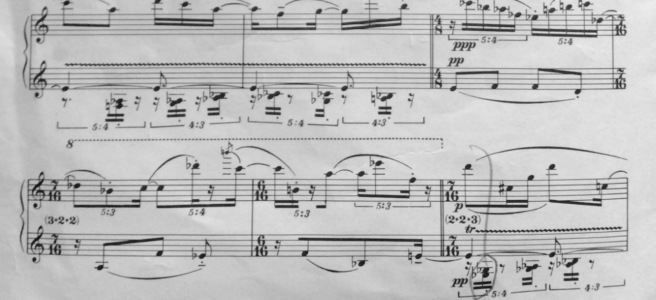Due to a hard disk failure, the Movement 6 recordings I made in the spring are being redone from September, and the time since has been valuable to reflect upon the approach to this extraordinary piano writing that I have taken.
The first edition score contains key directions for the pianist, but plenty of room for interpretation with the danger that the performer could forget about the overall indication of style from moment to moment when the texture needs to be maintained.
The technique appreciated for the performance of Ravel, Boulez, Liszt, Sorabji is also needed here for the lightness of touch that sustains a layer of bell like, legatissimo softness in the right hand (initially), alongside which the phrased melodic material can project. The composer indicates that there should be no crescendo in the groupetti layers, and this is the case everywhere except where the crescendo marks state.
The central section is divided into pairs of subsections that set up a kind of call and response, where the composer quotes earlier material from the sonata. The score indication is for a delicate sweetness, and after each response section, it is possible to use a short fermata to bring out the dramatic playfulness of the musical conversation. The rhythmic phrasing and staccato notes have to be full of clarity. A technical challenge in These passages is to play the trills in the left hand, without disturbance by the rhythmic diads also given to the left hand. A good deal of practice is needed, and in my case the right hand is used to assist with some of the seconds so as not to interrupt the trills for their full duration.
The image from the printed score shows part of this middle section including my added indication to use the right hand in the lower voice where necessary to maintain the evenness and technical independence of the trill. In fact for my smallish hands only the lower E flat is taken with the right hand, the G flat manageable with the left hand fifth finger while controlling the trill with thumb and second finger of course.
